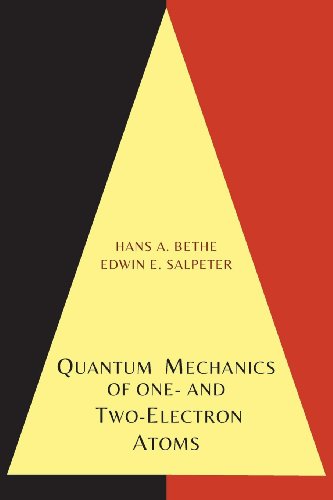Quantum Mechanics of One-and-Two-Electron Atoms pdf free
Par sevier thomas le mercredi, novembre 25 2015, 20:02 - Lien permanent
Quantum Mechanics of One-and-Two-Electron Atoms by Edwin E. Salpeter, Hans A. Bethe


Download eBook
Quantum Mechanics of One-and-Two-Electron Atoms Edwin E. Salpeter, Hans A. Bethe ebook
Publisher: Dover Publications
Format: djvu
ISBN: 0486466671, 9780486466675
Page: 375
And the big one: why do the two pillars of 20th century physics, quantum mechanics and Albert Einstein's general theory of relativity, not agree with each other? Can you recapitulate the essence of quantum mechanics in one or two sentences? They have to be qubits so they have to have two possible values. He also holds the title of Honorarprofessor in the Department of Physics at the Technical University of Munich, sits on the editorial board of several journals, and is one of the 2010 recipients of the Benjamin Franklin Medal. In this counter Thanks to quantum mechanics, we have super-precise clocks, lasers, semiconductors, and may one day have quantum computers, which would be the ultimate in multitasking. Electrons in atoms get angular momentum only in fixed increments (there's that quantum mechanics again, only fixed increments allowed) and for historical reasons, the first few increments are named “s,” “p,” “d,” and “f.” On the periodic the elements whose outer electrons are “s” form the two tall leftmost columns; the “p” elements are the big square on the right; the “d” elements are the big block in the middle; and the “f” elements are the two rows off at the bottom. The parent atom, hydrogen, is the starting point for the discipline of quantum chemistry. Electron pairing is uncommon because the rules of quantum mechanics typically make electrons loners. Imagine a world where objects can be in two different places at the same time and cats are locked in sealed containers with flasks of poison and objects that spew radiation. The hydrogen molecular ion which consists of one electron interacting with two nuclei. But why are there three generations in the first place? At the subatomic scale, we know there are three families of fundamental particles - called "generations" - and each one contains two quarks, a neutrino and a negatively charged particle (the lightest being the electron). In this article we will almost only focus on this experiment and its numerous variants, as, according to Nobel prize winner Richard Feynmann, [it] has in it the heart of quantum mechanics. In reality, it contains the As opposed to light, it was thought that all matter was made of atoms, and that these atoms were made of protons, neutrons and electrons. An atom is composed of sub particles, which are composed of either quarks, or an electron. Dividing atoms In this experiment, the researchers succeeded in keeping a single atom in two places more than 10 micrometers apart, that's a one-hundredth of a millimeter. (If you think Our deepest understanding of the atomic world comes from the advent of quantum theory. The researchers are doing this work because they want to build quantum mechanics bridges, by letting the atom being pulled apart touch adjacent atoms, forming a bridge between them. So they really behave according to quantum mechanics.
Astronomical algorithms book download
Meccan Trade and the Rise of Islam ebook